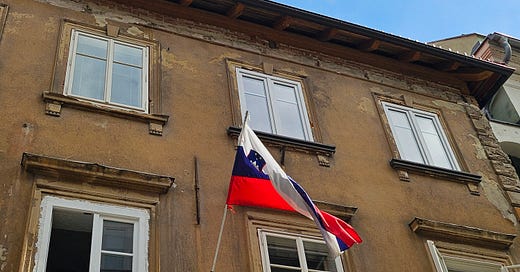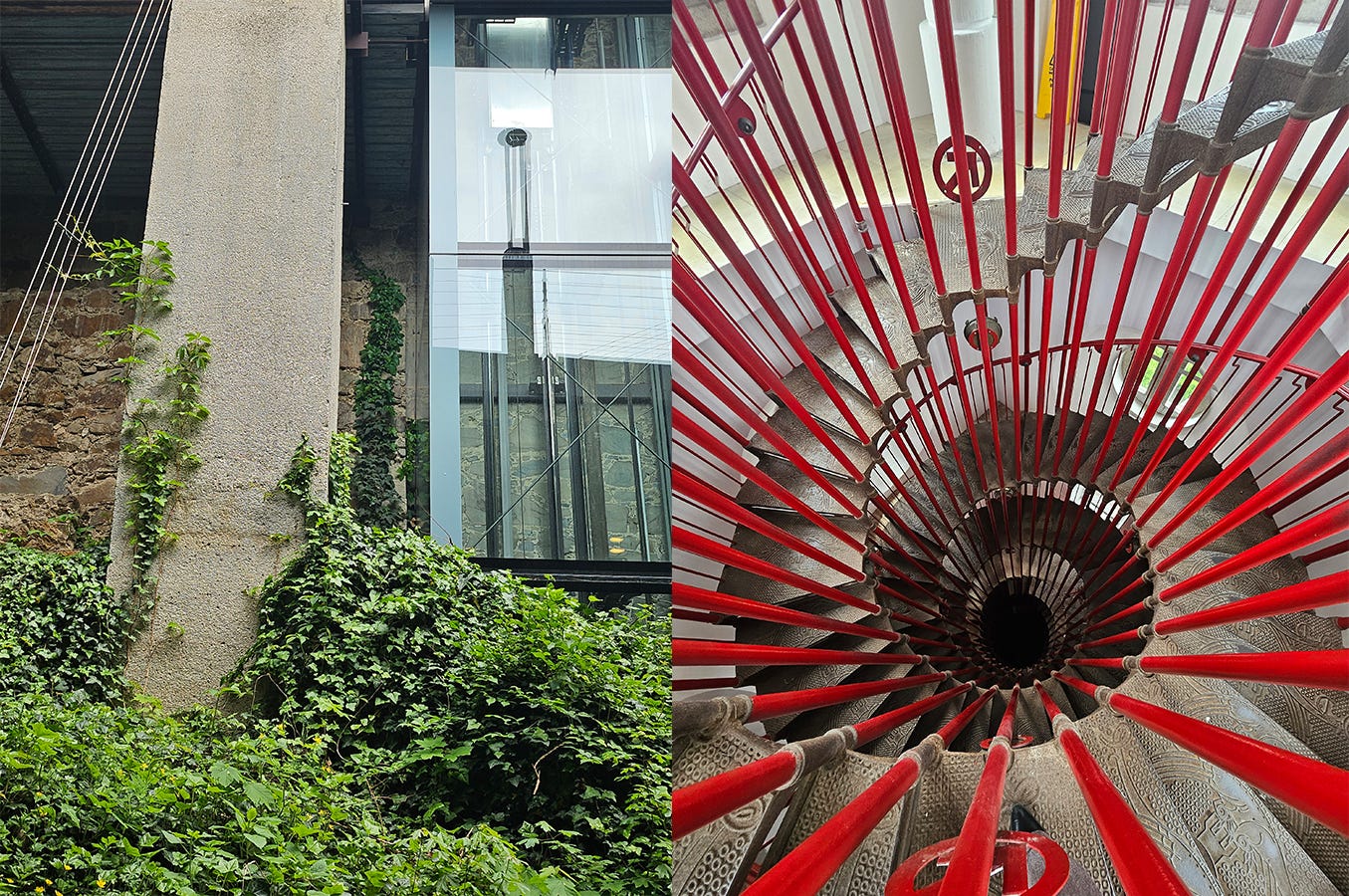I
The first time I stepped foot into Prešeren Square — now circular in layout, after a redesign by Edvard Ravnikar in the 1980s — I was hit with a wave of familiarity. I’ve seen this before, I thought, despite the truth that until that moment I had never been remotely close to Ljubljana. For a moment, facing east, I stood in place as the river of tourists continued to rush past me, and gazed: the monument to France Prešeren, Slovenia’s most famous poet, in front of me, the distinctive pink Franciscan Church to my left, the iconic art nouveau facade of the Galerija Emporium behind it, the Triple Bridge crossing the Ljublanica River to my right. A short walk along the river are other famous bridges built or renovated by the architect Jože Plečnik: the Cobbler’s Bridge, Dragon Bridge, and further along, the Trnovo Bridge. Thanks to the countless travel guides I consulted and the hi-res Google Maps photos I browsed before flying, my mind already had fairly accurate images of the city before I had even arrived.
Of course, images do not compare to presence. Breathing in the busy air at the riverwalks, listening to the cacophony of languages around me, and walking the cobbled streets in my trusty old boots continue to be experiences that evade the snares of virtuality (so far). It is hard to miss how Plečnik’s style — “traditional but modern” is the concise way it is often described as — has genuinely elevated Ljubljana in palpable ways. Human-centered, the city is a marvel of history and innovation, art and function. It’s a delight to be here. That I am in this beautiful city because of a poetry prize I had won last year astounds me every time I think about it. This opportunity affords me the pleasure of living in a new city for a month, and an abundance of time to dedicate to my creative work. Immersed in an entirely new environment, my mind feels sharp. From having to learn basic Slovene to get by to tracing with my strides a new geography, the unfamiliar keeps me on my toes.


So much of Ljubljana has inspired awe in me, but one that I keep going back to is the thought of how much the stones of these centuries-old buildings have endured — and, more importantly, the intentional efforts of people to breathe new life into them with the intention to honor collective memory. The Ljubljana Castle, for instance, is a 12th century medieval fortress that has been renovated with a care that, to me, did not diminish its heritage but exalted it. With a vision inherited from Plečnik, modern design and accessibility features have transformed this historic building into a cultural venue in such a way that the integrity of the original structure is maintained while making space for the needs of the present. A glass elevator partly covered by ivy is tucked between old stone next to what was once an open-air prison cell. A two-way spiral staircase — ingeniously designed! — painted a bright red allows visitors to safely climb to the peak of a tower that offers a fantastic view of Ljubljana. One of the halls has been completely renovated into an exhibition space that, at the time of my visit, showcased photographs by Marjan Ciglič. Beautiful photographs from the nineties, taken by the legendary Slovenian photojournalist, are displayed in the same room with walls that date back to the 1100s. Exploring the castle is feat of time travel.

In many ways, the Old Town of Ljubljana, where the residency apartment is located, is everything I imagined a European city would be. The cobblestone streets, countless bars and cafes in old buildings, stylish boutiques carrying local and artisan goods, incredibly well-dressed strangers. In walking through the streets I am keenly aware of the juxtaposition of everything I’ve read and seen about Europe — stereotypes and historical facts alike — on the present moment of my living in it. In exploring this new place, I do not start from scratch. Instead, with every day I spend here learning more about the place and its people, I am constantly overwriting what I know, building on my repository of collected images from both direct and indirect experiences. Knowing that Slovenia was once part of the former Yugoslavia is one thing; learning more intimate accounts of the experience of living through its violent dissolution is another. The fight for independence and recognition, the transition from a socialist republic to a parliamentary democracy, and the complicated feelings left in its aftermath must have taken a fierceness that, to me, manifests in the way Slovenes take pride in their language and culture. On her language, Slovenian novelist and critic Ana Schnabl writes, “The language I love is a game. I can approach it playfully and unconcernedly, but if ladies with red scarves encroach on my space, I will react fiercely, defensively.” With such passion for their language, it shouldn’t come as a surprise then to know that Ljubljana, home to 35 public libraries, multiple publishing houses, literary institutions, and book festivals, is one of 53 UNESCO Cities of Literature. In a conversation we had about the prolific literary production in the city, Miha Maurič, the program coordinator of the Tomaž Šalamun Poetry Center hosting my residency, said, “It was almost like literature saved our language.”
I see this fierceness, too, in the abundance of street art all over the city. Political sentiments, cartoon animals, colorful abstractions, and stickers create layered tapestries on city walls. They speak what is often unutterable, and mark the presence of those that have been rendered invisible. It is not insignificant that the heart of Ljubljana’s underground culture is Metelkova mesto, the former headquarters of the Yugoslav National Army. The artists and communities that have occupied this space since the nineties have fought against its conversion into a commercial space and for its recognition as an autonomous cultural center. Today this complex, covered with murals and sculptures everywhere you look, is a hub of creative activity. From Ljubljana to Manila, street art is a resistance against silence.

Woven into the story of Ljubljana is the symbol of the dragon. The legend goes: the mythological Greek hero Jason encountered a dragon dwelling by the Ljubljana marshes that, with the help of Medea, he had to slay. Transformed in the story, the dragon is now said to be perched atop the castle tower, guarding the city and its people. One can sense this fierce, watchful spirit in the graffiti on city walls, the vitality of the local literary scene, the fervor with which Slovenes define and defend their identity. A kind of radical love, I think. That the city name resembles the Slovene word for “the beloved”, “ljubljena”, acquires a new dimension in this light.
II
When I am abroad, I can’t help but think of home. The differences, both welcome and unwelcome, rise to the forefront of my attention as if on instinct, resulting in a mental concept map of where I am in relation to everywhere I’ve ever been to. The tender warmth of speaking to Filipino strangers is missed when I speak to Slovenes, though they are far from unfriendly. Coming from car-centric Texas and the chaotic streets of Manila, the drivers’ deference to pedestrians and bikers at crossings always surprises me. The robust public transportation in the city also strikes me as a wonder. Within a ten-minute walk from the residency apartment are, by my count, at least 12 bookstores, and this excludes the bookstores inside the nearby museums. Save for a small shelf or pile of books in English, German, or Italian, these bookstores purvey an incredible variety of books in Slovene. Meanwhile, from Johnson City, I would have to drive an hour for one. I thought, too, all the Filipino independent presses I wish had spaces of their own in which to gather the existing love for literature dispersed throughout the metro.
Time, too, as shaped by external markers is different, at least in the touristy Old Town: retail stores close at 7 or 8 o’clock, versus Manila’s 9:00 or 10:00 PM. Many establishments here are also closed on Sundays, which, in Manila, can actually be one of the busiest days of the week, especially with the integration of churches and shopping malls. When dining out in Ljubljana, servers never volunteer to bring the cheque after plates have been cleared, whereas in the US, it is often brought to the table even before you’ve asked for it with the gentle reminder of whenever you’re ready. The norm here, it seems, is that diners spend a significant amount of time after their meal conversing — sometimes with a drink, often while having a smoke.
Bordered by Austria to the north, Hungary to the northeast, Croatia to the southeast, and Italy to the west, Slovenia is considered a crossroads between central and eastern Europe. Indeed, cross-cultural influences abound in the capital. Jože Plečnik’s architectural vision for Ljubljana as we know it carries similiarities with the aesthetics of the Vienna Secession. The ruins of a Roman wall stands less than a kilometer away from Trg republike, one of the city’s Yugoslav-era monuments. Dragon Street Food along Ciril-Metodov trg sells cylindrical pastries they call Dragon Fire Bread that, as my spontaneous lunch companion from Frankfurt pointed out (long story for another day), resembles the Czech trdlník and the German Baumstriezel.
Everywhere, though, is a crossroads, isn’t it? On his painting All Seven Eastern Sins. Apotheosis, Konstantin Zvezdočotov writes:
Whenever I ask my colleagues from Poland, Croatia, Bulgaria or Georgia to tell me about the specificity of their national culture, I always pretty much get one and the same answer: “Our country is on the border between the East and the West; its culture is a mixture of Eastern and Western traditions.
That was certainly a familiar sentiment (with, of course, a more nuanced context within the discourse of European history), even though I do not come from any of those countries. Manila, with its deep colonial history and geographical proximity to multiple diverse nations, is also often described as a melting pot. Even the little town of Johnson City in Texas — which, to begin with, was once part of Mexico — has its obvious Mexican, German, and even French influences. What are we if not the collision — fusion, repulsion, and all — of everything that has touched us? Culture is always in flux, destined for impurity. The opposite, purity, is a delusion.
Read Part II below!









Way to go Lian! To be able to stay one month in a city like Ljubljana is my idea of wonderful traveling. I am looking forward to your next impressions which is the next best thing to being there. Thank you.
Missing both you and Michael but happy you two are having all these wonderful experiences at this time of your lives.